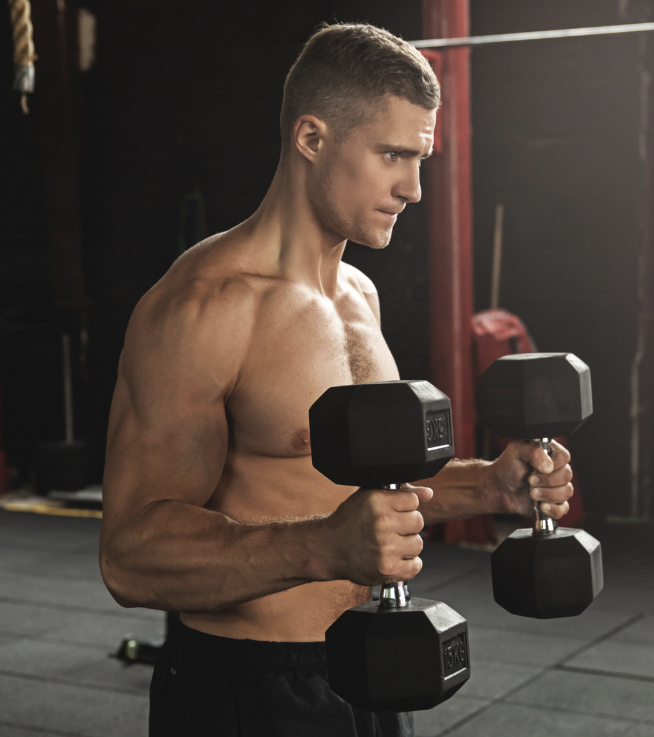

You've probably noticed by now...
There's a lot of curl variations.
Which one you should do depends on your goal and what you want to achieve.
There's two major variations that we'll look at in this article and that's the hammer curl and the bicep curl.
We'll break down the differences and when these variations should be used in your workouts.
When it comes to working the biceps, you’ve got to curl.
That, after all, is what the bicep does.
There are a lot of different curling exercises you could do but two of the best are hammer curls and dumbbell bicep curls.
These two exercises, though, are easily confused.
In this article, I’ll break down the differences, advantages and disadvantages of hammer curls and bicep curls.
I’ll also answer the most frequently asked questions about these two exercises.
The main difference between a bicep curl and a hammer curl comes down to your hand positioning when holding the dumbbells.
When you are performing the bicep curl with dumbbells your palm is facing up when you curl the weight up.
However, when you do a hammer curl, the palm is in a neutral position, as if you were holding a hammer.
This change in hand positioning has an impact on the target muscle group.
With the bicep curl you are equally activtaing the long head and the short head of the biceps.
However, the hammer curl will place the vast majority of the tension on the long head of the biceps.
When you are doing the neutral hammer curl, you will activate the brachialis much more than the standard biceps curl.
The supinated bicep curl grip will better activate the biceps.
It should be noted that both versions of the exercise will involve all of these muscles.
However, the different hand positions allow you to place more emphasis on the different areas.
The biceps is a two-headed muscle group that lies between the shoulder and the forearm.
It originates on the coracoid process of the scapula and inserts on the radial tuberosity of the forearm.
The job of the bicep is to flex the elbow.
It is also involved in raising the arm forward.
The two bicep ‘heads’ are known as the short head and the long head.
The biceps also help with supination of the forearms.
Another muscle that is important to know about is the brachialis, which lies beneath the biceps.
This muscle can generate about 50 percent more power than the biceps.
Even though you can’t actually see this muscle, the bigger it is, the more it will push up the biceps, to make the arm bigger.
If your goal is to develop biceps thickness, you should prioritize the hammer curl.
This will give your upper arm a broader look when your arms are at your side.
If you suffer from pain in the wrists, you should consider doing hammer curls over barbell curls, as they are less taxing on the wrists.
People who are lacking grip strength should also consider doing hammer curls.
If your goal is to develop the ‘meat’ of the biceps, and build peak, you should do the standard biceps curl.
Ideally, you should be doing both of these exercises to fully develop your upper arms.
One way is obviously to do both exercises in the same workout.
Another way is to alternate between hammer and standard curls from workout to workout.
A third option is to follow a periodization program.
This involves a two week phase where you are training with the standard biceps curl.
For the next two weeks, switch to the hammer curl.
Alternate between these two-week phases to complete your training cycle.
A variation of the standard hammer curl is to bring your hand up and across the body to end the curl at your upper chest level.
Your elbow should remain in one position throughout the movement.
This variation will recruit the forearm muscles more than the standard version of the exercise.
Hammer curls and bicep curls are not mutually exclusive.
You do not have to do either one or the other.
Ideally, you should do both exercises, within the same workout or in succeeding workouts, going back and forth between them.
This will allow you to effectively work all of the key muscles involved in building biceps strength and size:
I recommend working your biceps twice per week, choosing two or three exercises and 10-12 sets in total.
Use a descending rep scheme, where you add weight and drop reps each set.
On your heaviest set, you should be doing no fewer than six reps.
By doing both hammer curls and biceps curls, you’ll be able to build upper arms to impress.
No, hammer curls are not better than bicep curls.
Each exercise has its own merits, with the hammer curl doing a better job of targeting the brachialis and forearms.
In contrast the bicep curl will better activate the biceps brachii.
For bigger arm development, you should do both the hammer curl and the bicep curl.
No, hammer curls are not harder than bicep curls.
You will probably find, though, that you can lift slightly more weight with the hammer curl than the bicep curl.
That is not because the exercise is easier.
Rather, it’s because the hammer curl recruits more muscle groups, including those of the forearms.
Yes, hammer curls build biceps.
This exercise will directly work the brachialis which lies underneath the bicep brachii.
Even though it is not directly visible, when developed it will push the bicep out and up, to make it thicker and higher.
However, the hammer curl is not very effective at working the short head of the biceps.
To make sure that you get complete biceps development you should do other curl variations along with hammer curls.
Yes, hammer curls will help to thicken the biceps.
It does this by strengthening and building the brachialis, which lies underneath the biceps brachii.
So, when looked at from the side, the arms extended by the side will look thicker.
Yes, you can do hammer curls one at a time.
This is, in fact, the preferred way to do them.
When you train your limbs unilaterally, you will be stronger than when you work them both at the same time.
You should either do all of your reps for one arm and then repeat with the other arm.
A more natural way to go is to alternate arms to complete your rep count.
When you do this, make sure that you have completed a rep with one arm before starting your next rep with the other arm.
Yes, hammer curls will build your forearms.
The hammer curl will activate the brachioradialis, which is the main forearm muscle.
For even greater activation of this muscle, perform the exercise in a cross-over manner where you curl up and across the body to complete the curl at the upper chest level.
Be sure to keep your elbow in a fixed position when you do this.
There are a number of hammer curl variations, including the rope hammer curl, the cross body hammer curl, the preacher hammer curls, the cable hammer curls and the preacher hammer curl.
The neutral grip close grip chin up is another variation.
In this case, however, you bring your biceps up to the bar rather than the other way around.
Some bicep curl variations include spider curls, concentration curls, cable curls, barbell curls, EZ-bar curls, plate curls, Zercher curls, drag curls, incline dumbbell curls and alternating dumbbell curls.
Useful Links
 About FitFrek
About FitFrekFitFrek operates as an independent platform, offering comprehensive workouts, programs, routines, guides, and unbiased reviews to accelerate your progress. We pride ourselves on our honesty, delivering straightforward and candid insights. FitFrek does not offer medical advice, diagnosis, or treatment services.